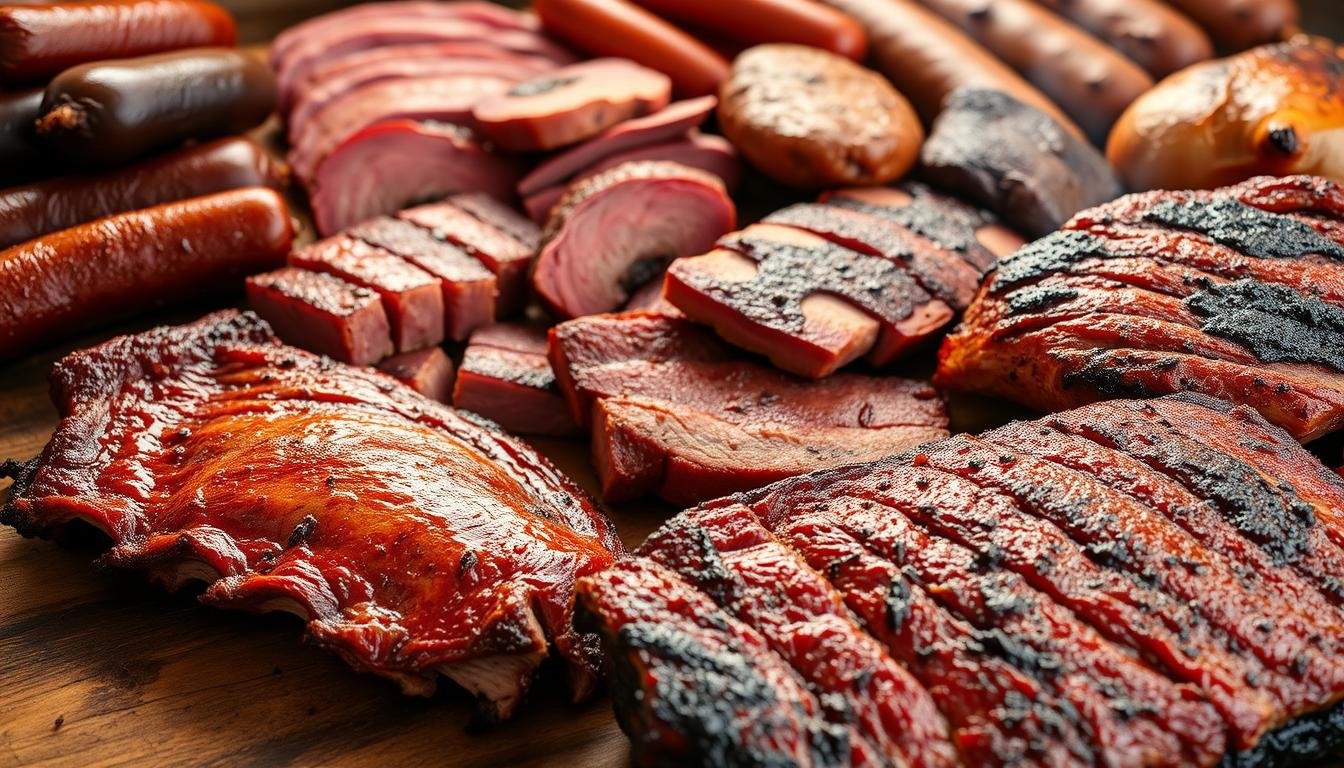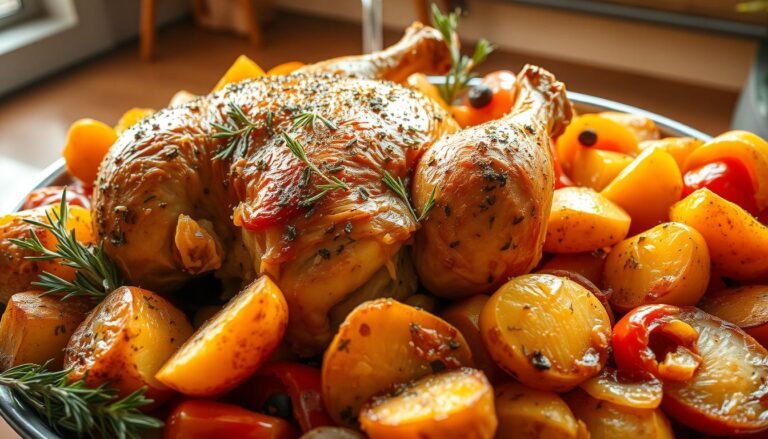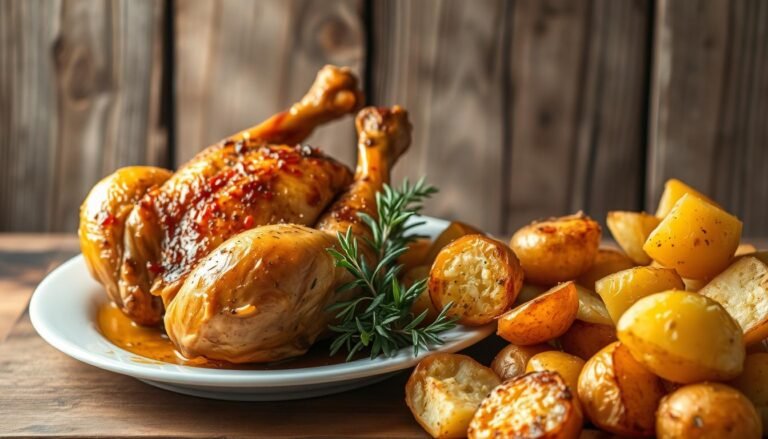“12 Best Smoked Meat Recipes – Flavorful and Easy to Make!”
Imagine a lazy Saturday afternoon with your smoker humming softly. The smell of perfectly smoked meats fills your backyard. For BBQ lovers and home cooks, smoking meat is more than cooking—it’s an art that turns simple ingredients into amazing dishes.
Smoked meat recipes are a favorite in many American kitchens. Whether you’re new to smoking or have years of experience, these recipes will take your cooking to the next level. You’ll learn to make tender pork loins and juicy chicken wings, just like restaurants.
Get set to dive into a world of deep flavors and learn pro smoking techniques. Impress your loved ones with delicious smoked dishes that are ready in under 3 hours.
- Understanding the Art of Smoking Meat
- Best Smoked Meat Recipes for Beginners
- Classic Pork Smoking Techniques
- Beef Smoking Mastery
- Poultry and Seafood Smoked Meat Recipes
- Essential Smoking Times and Temperatures
- Popular Marinades and Rubs for Smoked Meats
- Troubleshooting Common Smoking Issues
- Conclusion
- FAQ
- What type of smoker is best for beginners?
- How long does it take to smoke different types of meat?
- What are the best woods for smoking different meats?
- How do I prevent my smoked meat from drying out?
- What internal temperature should I aim for when smoking meat?
- Can I smoke frozen meat?
- How often should I add wood chips during smoking?
- What's the difference between a dry rub and a marinade?
- How do I clean and maintain my smoker?
- Can I smoke vegetables along with meat?
- Source Links
Understanding the Art of Smoking Meat
Smoking meat turns simple cuts into amazing dishes. It’s a skill anyone can learn, from beginners to seasoned pitmasters. Knowing the basics of smoking is essential.
There are many smoker types for both home cooks and chefs. The right smoker can greatly affect your cooking and flavors.
Exploring Smoker Varieties
Each smoker type offers a unique cooking experience:
- Drum smokers: Compact and efficient
- Pellet smokers: Automated temperature control
- Bullet smokers: Portable and versatile
- Offset smokers: Traditional design with separate firebox
Essential Smoking Equipment
Having the right tools is crucial for smoking success. Key items include:
- Reliable thermometer
- Heat-resistant gloves
- Meat probes
- Quality tongs
- Water pan for moisture control
Selecting Wood Chips for Smoking
Choosing the right wood chips is key for flavor. Different woods pair well with different meats:
| Wood Type | Flavor Profile | Best Meat Pairing |
|---|---|---|
| Hickory | Strong and smoky | Pork shoulder |
| Mesquite | Bold and intense | Beef |
| Apple | Sweet and mild | Chicken |
| Cherry | Fruity and subtle | Pork |
Keep the ideal smoking temperature around 250°F. Managing temperature is key to perfect smoked meats.
Best Smoked Meat Recipes for Beginners
Starting with smoked meat recipes might seem scary, but it’s easier than you think. With some guidance, you’ll be a pro at smoking meats in no time. These recipes are great for beginners or anyone looking to improve their cooking skills.
Here are some easy smoked meat recipes for beginners:
- Smoked Pulled Pork Butt: Perfect for big gatherings and learning to smoke
- Smoked Whole Chicken: Great for family meals and easy to make
- Smoked Pork Chops: Ready in under 90 minutes, quick and tasty
- Smoked Hamburgers: A tasty twist on fast food
The 3-2-1 method for ribs is a must-try for beginners. It makes ribs tender with little effort. Pork butt is also great for newbies, making it a perfect first choice.
Pro tip: Get a good smoker like the Camp Chef Smoke Pro for consistent results. Remember, smoking is all about patience. Low and slow is the secret to tender, delicious meats.
“Time is the most important ingredient in smoking,” as Chef Matt Horn wisely says.
When picking your first recipe, think about cooking time, ingredients, and your skill level. Start simple, get good at controlling the temperature, and you’ll be making amazing smoked dishes in your backyard.
Classic Pork Smoking Techniques
Smoking pork is an art that turns simple cuts into delicious treats. Whether you’re a backyard BBQ fan or a serious pitmaster, learning to smoke pork can boost your cooking skills.
Pork is great for smoking, with favorites like pork butt and ribs. The secret to great smoked meat rubs is knowing about temperature control, brining, and how long to smoke.
Temperature Control Tips
Keeping the temperature steady is key for smoking pork. Here are some tips:
- For pork butt, aim for a smoker temperature around 250°F
- Use a fast smoking method at 300°F to reduce cooking time
- Monitor internal meat temperature carefully
Brining and Seasoning Methods
Boost your pork’s taste with these methods:
- Apply 2-3 tablespoons of yellow mustard as a base
- Use ¼ cup of smoked meat rubs for optimal seasoning
- Let the meat rest with rub for 30 minutes before smoking
Smoking Duration Guidelines
Smoking times depend on the cut and weight:
| Pork Cut | Weight | Smoking Time | Internal Temp |
|---|---|---|---|
| Pork Butt | 5-8 lbs | 12-14 hours | 205°F |
| Pork Loin Roast | 2-5 lbs | 1.5-3 hours | 145°F |
Pro tip: Always let your smoked pork rest for 1-2 hours before pulling or serving to ensure maximum tenderness and flavor retention.
Beef Smoking Mastery
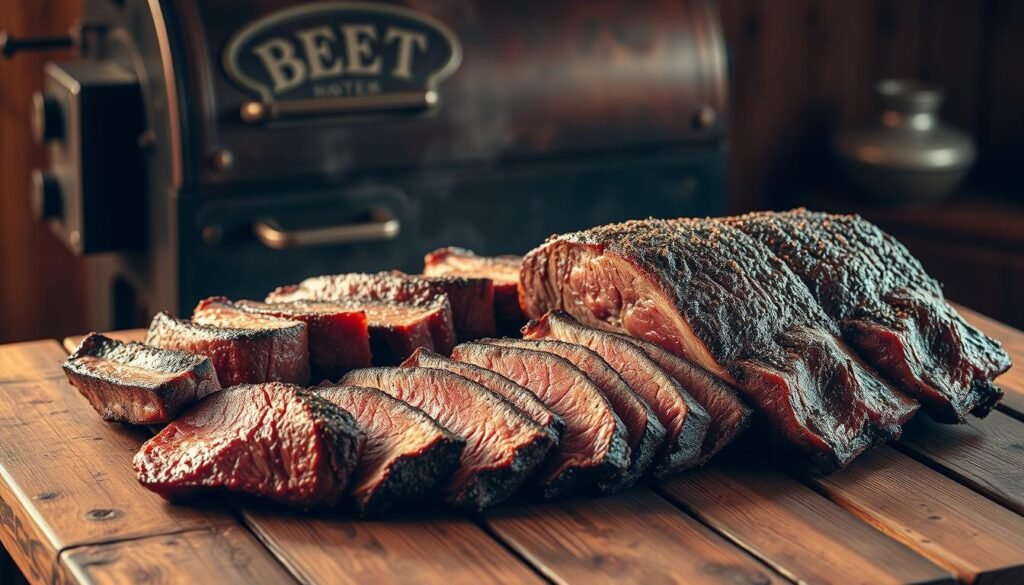
Smoking beef is an art that turns tough cuts into delicious treats. Beef is very versatile for smoking, with chuck roast and brisket being top choices. They are perfect for slow cooking.
Choosing the right cut is key for great beef smoking. Choice grade beef has the best flavor and tenderness. Here are some tips for preparing your beef:
- Choose cuts with good marbling
- Trim excess fat to about ¼ inch thickness
- Apply a robust dry rub before smoking
Keeping the right temperature is important. For chuck roast, keep your smoker at 225°F to 250°F. A 3-4 pound roast needs 6-7 hours of smoking, plus an extra hour to rest. Aim for an internal temperature of 195°F for sliced beef or 205°F for pulled-style meat.
Choosing the right wood is crucial for flavor. Pecan and oak woods are great for beef, adding a rich smoky taste. Dry brining your meat for 12-24 hours before smoking will make it even more flavorful and tender.
Pro tip: Use a temperature probe to monitor internal meat temperature without repeatedly opening your smoker.
Your goal is to get a perfect bark and smoke ring. With patience and practice, you’ll become a pro at smoking beef. Your BBQ will impress everyone.
Poultry and Seafood Smoked Meat Recipes
Smoking poultry and seafood brings new flavors to the table. These proteins need special care to stay moist and develop deep smoky tastes.
Exploring smoking methods for poultry and fish reveals unique techniques. These methods keep the meat tender and add amazing flavors.
Whole Chicken Smoking Guide
Smoking a whole chicken needs precision. Here are some tips for success:
- Brine for 3 hours using a solution of:
- 1/2 gallon water
- 1/2 cup kosher salt
- 1/2 cup dark brown sugar
- Use pecan wood for the best flavor
- Keep the smoker at 230°F
- Cook until the thighs hit 175°F
Turkey Smoking Techniques
Turkey needs careful smoking to avoid drying out. Here are some recommended methods:
- Brine for 3-12 hours
- Smoke at 225°-275°
- Cook for about 35 minutes per pound
- Make sure it reaches 165°F inside
Fish Smoking Basics
Seafood smoking comes with its own set of challenges. Delicate fish needs gentle handling and shorter cooking times. Choose firm fish like salmon or trout for the best results.
Pro tip: Always let smoked poultry and seafood rest for 10 minutes after cooking. This helps keep juices in and flavors rich.
Essential Smoking Times and Temperatures
Mastering smoking methods means knowing the right temperatures and cooking times for various meats. It’s key to keep the internal temperature and cooking time right to avoid foodborne illnesses.
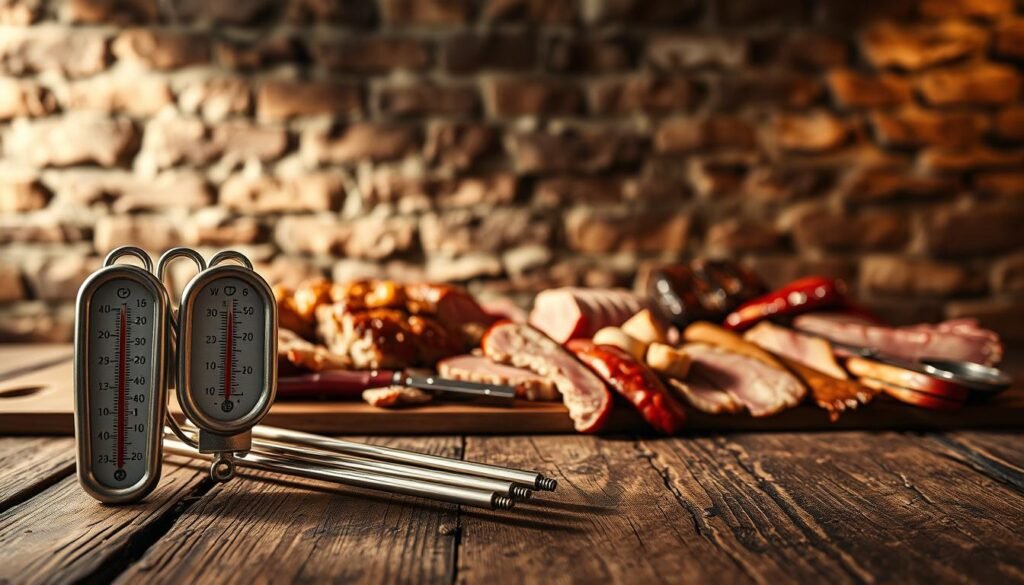
Different meats need different smoking techniques. Here’s a detailed guide to help you get the best results:
- Brisket: Smoke at 225°F to 250°F for 12-18 hours
- Target internal temperature: 195°F to 205°F
- Average cooking time: 1.5 hours per pound
- Pork Shoulder: Smoke at 225°F for 8-12 hours
- Target internal temperature: 195°F to 205°F
- Similar cooking rate to brisket: 1.5 hours per pound
- Ribs: Smoke at 225°F for 5-6 hours
- Target internal temperature: 190°F
- Chicken: Smoke at 250°F to 275°F for 2-4 hours
- Target internal temperature: 165°F
Several factors affect smoking times. These include meat size, thickness, and external conditions. Weather and the type of smoker can also affect temperature consistency. Electric smokers offer precise control, while charcoal smokers require more skill but add rich flavors.
Pro tip: Always use a reliable meat thermometer to ensure smoked meat safety and perfect doneness.
Choosing the right wood is crucial for flavor. Different woods like hickory, mesquite, apple, and cherry give unique tastes to your smoked meats. Soaking wood chips for about 30 minutes helps prevent them from burning too fast and improves smoke quality.
Popular Marinades and Rubs for Smoked Meats
Improving your smoked meat dishes starts with the right rubs and marinades. These add-ons turn simple cuts into gourmet delights. They bring out the meat’s true flavors in every bite.
Mastering seasoning is key to better smoking. You can make marinades quickly with items like soy sauce, olive oil, and garlic. These are common in most kitchens.
Basic Dry Rub Recipes
Making a great dry rub takes skill and creativity. Here are some tips for making top-notch smoked meat rubs:
- Use 2 tablespoons of rub per 1.5 pounds of protein
- Let rubs sit on the meat for 15 minutes to 2 hours
- Keep dry rubs in airtight containers for up to 6 months
Wet Marinade Combinations
Wet marinades can change your meat’s taste. Timing is key. Marinate thin cuts like skirt steak for 2-4 hours. Thicker cuts can soak up flavors for up to 8 hours.
Regional BBQ Sauce Styles
BBQ sauces vary by region. You’ll find tangy vinegar sauces and sweet tomato sauces. Each type pairs well with different smoked meats.
| Region | BBQ Sauce Characteristic |
|---|---|
| Texas | Bold, spicy with cumin and mustard seeds |
| Memphis | Paprika-heavy with complex spice blend |
| Korean | Sweet with sesame seeds and brown sugar |
Remember, the secret to amazing smoked meats is trying different marinades and rubs. Your taste buds will love it!
Troubleshooting Common Smoking Issues
Mastering barbecue techniques means solving common smoking challenges. Knowing these issues helps keep your smoked meat safe and tasty.
Keeping the temperature right is key. The best smoking temperature is between 220°F and 250°F. Even small changes can affect the meat’s quality and safety.
- Monitor smoker temperature consistently
- Use external meat thermometers for accuracy
- Inspect smoker components regularly
- Clean equipment after each use
Wind and humidity can mess with your temperature. Place your smoker in a sheltered spot to keep the heat steady. In cold weather, you might need to add extra heat.
| Common Issue | Potential Cause | Solution |
|---|---|---|
| Uneven Cooking | Poor Heat Distribution | Rotate Meat Periodically |
| Temperature Drops | Air Leaks | Check Smoker Seals |
| Excessive Smoke | Wood Pellet Overload | Use Recommended Pellet Quantity |
Electrical problems can also affect your smoking. Make sure power connections, temperature probes, and control boards are working well. Also, keep wood pellets dry to avoid auger jams.
Smoking well is about knowing your stuff and being patient. By practicing these techniques, you’ll improve your smoked meat safety and cooking skills.
Conclusion
Learning to make smoked meat recipes is like starting a new adventure in cooking. You’ll discover new tastes by trying different smoking methods and wood types. Whether you’re cooking a chuck roast for 6 hours or a beef tenderloin, you’ll get better with each try.
Adding the right sides to your smoked meats can make your meal even better. Try pairing your smoky dishes with coleslaw, roasted veggies, or cornbread. These sides can turn a good meal into an amazing one. You’ve learned about controlling temperature, choosing the right wood, and being patient.
Now, you can try many new recipes with your newfound skills. You know how to cook beef tenderly and how to smoke it perfectly. Remember, the more you practice, the better you’ll get. You’re on your way to becoming a master pitmaster in your kitchen.
With the right tools and techniques, you can make any meat into a special dish. Keep learning, trying new flavors, and enjoy sharing your food with others. It’s all about the journey and the joy of cooking.
FAQ
What type of smoker is best for beginners?
How long does it take to smoke different types of meat?
What are the best woods for smoking different meats?
How do I prevent my smoked meat from drying out?
What internal temperature should I aim for when smoking meat?
Can I smoke frozen meat?
How often should I add wood chips during smoking?
What’s the difference between a dry rub and a marinade?
How do I clean and maintain my smoker?
Can I smoke vegetables along with meat?
Source Links
- 24 Quick Smoker Recipes: 3 Hours Or Less – https://bbqgrillrecipes.com/quick-smoker-recipes/
- 51 Delicious Recipes That Use Liquid Smoke – https://www.tasteofhome.com/collection/liquid-smoke-recipes/?srsltid=AfmBOorpyw5thEBkDc99KcDFDA4ErfoOME2oRmpscfnAJy3a0c8S2Mhk
- Smoking Secrets: A Step-by-Step Guide to Smoking Meats at Home – https://www.theflyingbutcher.com/blog/smoking-secrets-a-step-by-step-guide-to-smoking-meats-at-home
- Smoking Meats 101: What is Meat Smoking and Why You Should Try It – https://themeatstick.com/blogs/tips-recipes/smoking-meats-101-what-is-meat-smoking-and-why-you-should-try-it?srsltid=AfmBOooMWUtuUKJMDueqJUXX8XAqtUMVFGg9vqfmLOJCD0OMYGoXay4J
- Best Meats to Smoke – Hey Grill, Hey – https://heygrillhey.com/best-meats-to-smoke/
- 43 Best Smoker Recipes To Try: Beef, Pork, Lamb, Chicken + More – https://www.smokedbbqsource.com/best-smoker-recipes/
- 15 Next-Level Smoked Food Recipes to Try – https://www.foodandwine.com/smoker-recipes-6404676
- Five Hour Smoked Pork Butt – Learn to Smoke Meat with Jeff Phillips – https://www.smoking-meat.com/five-hour-smoked-pork-butt
- Smoked Pork Roast – https://thebigmansworld.com/smoked-pork-roast/
- Smoked Sloppy Joes – Learn to Smoke Meat with Jeff Phillips – https://www.smoking-meat.com/smoked-sloppy-joes
- Ultra Juicy Smoked Beef Chuck Roast Recipe | Urban Cowgirl – https://urbancowgirllife.com/ultra-juicy-smoked-beef-chuck-roast-recipe/
- Smoked Pulled Chicken – Learn to Smoke Meat with Jeff Phillips – https://www.smoking-meat.com/smoked-pulled-chicken
- Tender and Delicious Smoked Whole Chicken • Smoked Meat Sunday – https://www.smokedmeatsunday.com/smoked-whole-chicken-recipe/
- Meat Smoking Guide – How to Smoke Meat – American Meathead – https://americanmeathead.com/meat-smoking/
- How to Smoke Meats at Home: Basics of Smoking Techniques | Cosmo Appliances – https://cosmoappliances.com/how-to-smoke-meats-at-home-basics-of-smoking-techniques/
- Best Marinade Recipes – https://overthefirecooking.com/best-marinade-recipes/
- 13 BBQ Rub Recipes That Will Make Any Meat Taste Amazing – https://www.bhg.com/recipes/grilling/marinades-rubs/bbq-rub-recipes/
- Best Steak Marinade in Existence – https://www.allrecipes.com/recipe/143809/best-steak-marinade-in-existence/
- How to Use an Electric Smoker: Tips and Tricks – https://harkbbq.com/blogs/recipes-tips-guides/how-to-use-an-electric-smoker-tips-and-tricks?srsltid=AfmBOoq4zvZMoqvjokH07F8yIlq4eObp7hDIRZEzcmMom2crXv5O9vOB
- Pit Boss Troubleshooting – https://www.webstaurantstore.com/guide/1049/pit-boss-troubleshooting.html?srsltid=AfmBOoqaeLZX_Zm0i0sC_56pPqBp1FmemhgmzpprMye-YFJEIOP9Unfp
- Smoked Chuck Roast Recipe – https://www.dontsweattherecipe.com/smoked-chuck-roast-recipe/
- Recipe: Smoked Beef Tenderloin – Butcher BBQ – https://butcherbbq.com/blogs/news/elevate-your-backyard-bbq-with-smoked-beef-tenderloin?srsltid=AfmBOorv9HnhFEICDdTQIx8S5ET9YQT9y1VbjVs0xf0xm6Dge6asNcnU
- Smoked Beef Hammer Recipe on the Meadow Creek BX25 – https://www.meadowcreekbbq.com/blog/smoked-beef-hammer-recipe-on-the-meadow-creek-bx25/?srsltid=AfmBOopRb4Ce7N9a91qJBghW02DuHMR0-E9koW6RtpwKmI80R6H1Rvt7

